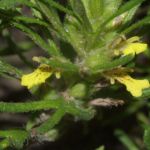| Common Name: |
Yellow Bugle |
| Other Names: |
Ground Pine |
| Botanical Name: |
Ajuga chamaepitys |
| Genus: |
Ajuga |
| Family: |
Lamiaceae |
| Native Location: |
Europe and N Africa, on dry bare ground. |
| Cultivation: |
Ajuga chamaepitys thrives in poor dry soil in full sun. Ajuga reptans and it cultivars may also be divided at any time if kept moist. Cultivars of A reptan do not come true from seed. |
| Propagation: |
By seed sown in autumn or spring. Germination may be erratic. Ajuga reptans and its cultivars may also be divided at any time if kept moist. Cultivars of A. reptans do not come from from seed. |
| Harvest: |
Leaves (A chamaepitys) are gathered in summer and dried for infusions and liquid extracts. Plants (A. reptans) are cut in summer; usually used fresh, in ointments or medicated oils. |
| Height: |
15cm (6in) |
| Width: |
15cm (6in) |
| Hardiness: |
Z6-10 |
| Parts Used: |
Leaves |
| Properties: |
A stimulant, diuretic herb that acts mainly on the urinary system and uterus. |
| Medicinal Uses: |
Internally for gout, rheumatism, and menstrual problems. |
| Bibliography: |
Encyclopedia of Herbs by Deni Brown Copyright © 1995, 2001 Dorling Kindersley Limited Pp 108 |

